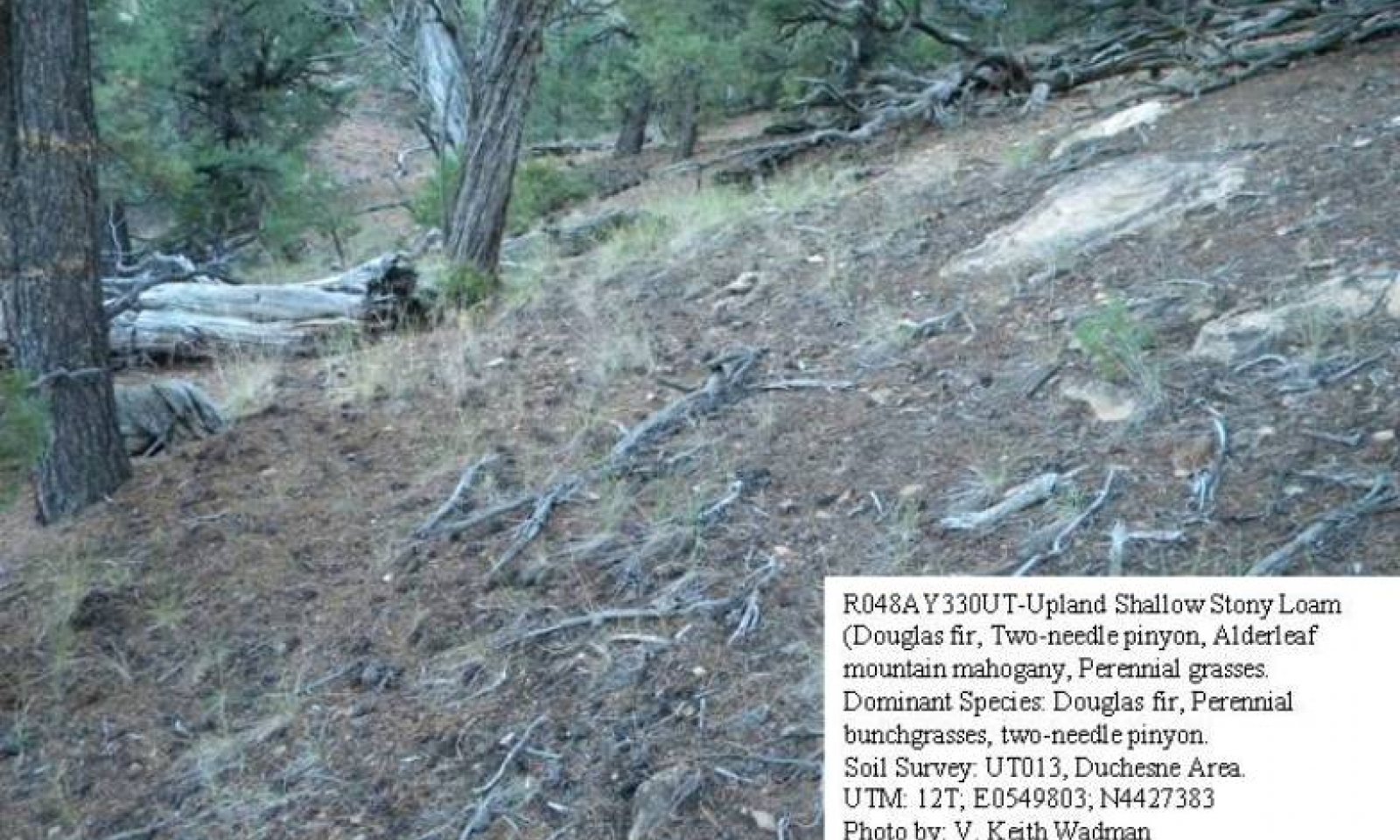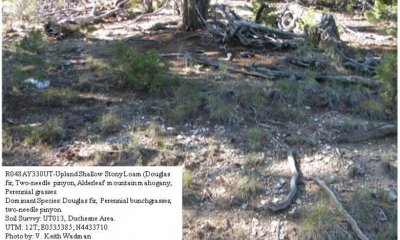
Upland Shallow Stony Loam (Two-Needle Pinyon /Douglas Fir)
Scenario model
Current ecosystem state
Select a state
Management practices/drivers
Select a transition or restoration pathway
- Transition T1A More details
-
No transition or restoration pathway between the selected states has been described
Target ecosystem state
Select a state
Description
This state describes the biotic communities that may become established on this ecological site if all successional sequences are completed under natural disturbance conditions. The reference state is generally dominated by an overstory canopy of Douglas fir. Two-needle-pinyon often acts as a co-dominate species, lesser amounts of Utah juniper may also be present. All age classes of Douglas fir are present in the reference state. Alderleaf mountain mahogany is the dominate shrub species. Bluebunch wheatgrass, Salina wildrye and Geyer sedge are the most common grass or grasslike species. Other native grasses, forbs, and shrubs may produce significant composition in the plant community.
The primary disturbance mechanisms are overstory canopy density, weather fluctuations, and fire or lack of fire. The reference state is self sustaining and resistant to change due to a high resistance to natural disturbances and a high resilience following those disturbances. When natural disturbances occur, the rate of recovery can be quite variable. Typically in the reference state, this ecological site will naturally fluctuate between community phases 1.1 and 1.2.
Reference State: Plant communities influenced by canopy density, long term weather fluctuations, and periodic fire.
Indicators: A community dominated by Douglas fir, two-needle pinyon, Utah juniper and alderleaf mountain mahogany. The density of the overstory canopy determines the amount and composition of the other native perennial grasses, grasslikes and forbs that may be present.
Feedbacks: Natural fluctuations in weather patterns that allow for a self sustaining Douglas fir, two-needle pinyon, Utah juniper, alderleaf mountain mahogany and native grass and grasslike community. Insect herbivory, more frequent fires, or other disturbances that may allow for the establishment of invasive species.
At-risk Community Phase: All communities are at risk when native plants are stressed and nutrients become available for invasive plants to establish.
Trigger: The establishment of invasive plant species.
Submodel
Description
The current potential state is similar to the reference state, however invasive species are now present in all community phases.
This state describes the biotic communities that may become established on this ecological site if all successional sequences are completed under natural disturbance conditions.
The current potential state is generally dominated by an overstory canopy of Douglas fir where logging has not occurred. Two-needle-pinyon often acts as a co-dominate species, lesser amounts of Utah juniper may also be present. All age classes of Douglas fir are present in the non-logged current potential state. Alderleaf mountain mahogany is the dominate shrub species. Bluebunch wheatgrass, Salina wildrye, cheatgrass and Geyer sedge are the most common grass or grasslike species. Other introduced and native grasses, forbs, and shrubs may produce significant composition in the plant community.
The primary disturbance mechanisms are overstory canopy density, weather fluctuations, livestock grazing use, logging and fire or lack of fire. The current potential state is still self sustaining but has a lower resistant to change due to a reduced resistance to disturbances. When disturbances do occur, the rate of recovery can be highly variable.
Current Potential State: Plant communities influenced by livestock grazing, logging, wildlife browsing, insect herbivory, weather fluctuations, fire periods and surface disturbances.
Indicators: A community dominated by Douglas fir, two-needle pinyon, Utah juniper and alderleaf mountain mahogany. The density of the overstory canopy determines the amount and composition of the other introduced and native grasses, grasslikes and forbs that may be present.
Feedbacks: Natural fluctuations in weather patterns that allow for a self sustaining Douglas fir, two-needle pinyon, Utah juniper, alderleaf mountain mahogany and native grass and grasslike community. Insect herbivory, more frequent fires, or other disturbances that may allow for the increase of invasive species.
At-risk Community Phase: All communities are at risk when native plants are stressed and nutrients become available for invasive plants to establish.
Submodel
Mechanism
This transitional pathway occurs when any combination of improper livestock grazing and logging allows non-native, invasive species to invade the site, the perennial herbaceous community is often reduced allowing species such as cheatgrass, Russian thistle and other weeds to become established. Broom snakeweed may also increase during this time. Once invasive species occupy the site, a threshold has been crossed. Cheatgrass, however, has been known to become established in healthy communities on this site.
Model keys
Briefcase
Add ecological sites and Major Land Resource Areas to your briefcase by clicking on the briefcase (![]() ) icon wherever it occurs. Drag and drop items to reorder. Cookies are used to store briefcase items between browsing sessions. Because of this, the number of items that can be added to your briefcase is limited, and briefcase items added on one device and browser cannot be accessed from another device or browser. Users who do not wish to place cookies on their devices should not use the briefcase tool. Briefcase cookies serve no other purpose than described here and are deleted whenever browsing history is cleared.
) icon wherever it occurs. Drag and drop items to reorder. Cookies are used to store briefcase items between browsing sessions. Because of this, the number of items that can be added to your briefcase is limited, and briefcase items added on one device and browser cannot be accessed from another device or browser. Users who do not wish to place cookies on their devices should not use the briefcase tool. Briefcase cookies serve no other purpose than described here and are deleted whenever browsing history is cleared.
Ecological sites
Major Land Resource Areas
The Ecosystem Dynamics Interpretive Tool is an information system framework developed by the USDA-ARS Jornada Experimental Range, USDA Natural Resources Conservation Service, and New Mexico State University.






